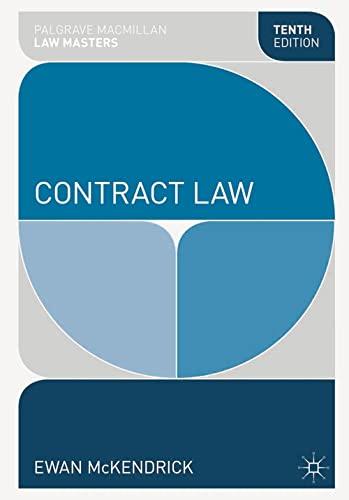Question
Indicate whether each statement is true or false. Then, change the italicized word or phrase of each false statement to make it true. Answers 1.
Indicate whether each statement is true or false. Then, change the italicized word or phrase of each false statement to make it true.
Answers
1. A tort is a wrong against society.
2. Under the doctrine of respondeat superior, a governmental body is immune from tort liability.
3. In the past, charitable institutions and government bodies were immune from tort liability.
4. "Master" is the legal name that means employer.
5. Several liability means that all joint tortfeasors must be named as defendants in a lawsuit.
6. Minor children are liable for their torts just the same asadults.
7. In comparing a tort with a breach of contract, a tort is a breach of duty imposed by the parties, whereas a breach of contract is a breach of duty imposed bylaw.
8. A tort is a criminal action brought by the state to punish the defendant for the wrongdoing.
9. If one joint tortfeasor is required to pay more than his or her share to the injured party, he or she may sue the other joint tortfeasor for the excess.
10. An agent is a person who is authorized to act on behalf of another and subject to the other's control.
Checking Terminology From the list of legal terms that follows, select the one that matches each definition.
answers
a.acquitted
b.actionable
c.assault
d.battery
e.conversion
f.damages
g.deceit
h.defamation
i.emotional distress
j.false arrest
k.false imprisonment
l.fraud
m.intentional infliction of emotional distress
n.intentional torts
o.invasion of privacy
p.libel
q.malicious prosecution
r.misrepresentation
s.nuisance
t.per se
u.private nuisance
v.public nuisance
w.right of privacy
x.scienter
y.slander
z.tortious
aa.trespass
bb.trespass de bonis asportatis
cc.unintentional torts
dd.waste
ee.willful torts
1.The wrongful act of damaging another's character or reputation by the use of false statements.
2.Defamation that is communicated by a writing or by other means that is directed toward the sense of sight.
3.Defamation that is communicated by the spoken word.
4.In and of itself; taken alone.
5.Prosecution begun in malice without probable cause.
6.The intentional and unauthorized entry on the land of another.
7.The wrongful exercise of dominion and control over the personal property in another's possession.
8.Wrongful; implying or involving tort.
9.Torts that are committed intentionally. (Select two answers.)
10.The intentional contact with another person without that person's permission andwithout justification.
11.The intentional creation of a reasonable apprehension of an imminent battery.
12.The intentional confinement of a person without legal justification. (Select two answers.)
13.A misrepresentation of a material, existing fact, knowingly made, that causes someone reasonably relying on it to suffer damages. (Select two answers.)
14.A false or deceptive statement or act.
15.The monetary loss suffered by a party as a result of a wrong.
16.Discharged from accusation.
17.That which creates or affords a basis to sue.
18.Trespass for goods carried away.
19.Emotional suffering caused by the infliction of extreme and outrageous intentional conduct by another.
20.Knowingly.
21.Negligent or accidental torts.
22.A violation of the right of privacy.
23.The use of one's property in a way that causes annoyance, inconvenience, or discomfort to another.
24.A nuisance that affects the community at large.
25.The right to be left alone, the right to be free from uncalled-for publicity, and the right to live without unreasonable interference by the public in private matters.
26.The abuse or destructive use of property that is in one's rightful possession.
27.A nuisance that disturbs one neighbor only.
28.Emotional suffering caused by the infliction of extreme and outrageous intentional conduct by another.
Negligence and Product Liability. Fill in the blanks below. While shopping in a grocery store, Alison slipped on some liquids that had accumulated in the floor where samples of a new iced tea were being given away. Alison was a(n) (customer), and the (carelessness) of the store employees, who were not (cautious), caused the accident. Because the wrongful act was not extreme, the degree of wrong would probably be considered rather than . The physician who treated Alison for her injuries was capable and not responsible for , although the amount of the physician's bill became part of Alison's . When Alison arrived home, she noticed a police car in front of her house and saw a police officer inside. The officer, who was a(n) , told her that a neighborhood child had wandered without permission into Alison's pool area and had almost drowned. A friend of Alison, who was visiting at the time, had rescued the child from drowning. The legal status of the friend was that of a(n) . Because the child was a trespasser, Alison's obligation to her would normally have been to refrain from unless the doctrine required her to use ordinary care. Should the case go to court, the jury, which is the , will have to determine whether the child was negligent if the state follows the doctrine of or the percentage of negligence of each party if the state follows the doctrine of . Because it is not probable, but merely possible, that Alison was negligent, the plaintiff would not be able to use the doctrine of to prove the case. Similarly, it is doubtful that Alison can use the defense of or if suit is brought promptly.
Step by Step Solution
There are 3 Steps involved in it
Step: 1

Get Instant Access to Expert-Tailored Solutions
See step-by-step solutions with expert insights and AI powered tools for academic success
Step: 2

Step: 3

Ace Your Homework with AI
Get the answers you need in no time with our AI-driven, step-by-step assistance
Get Started


